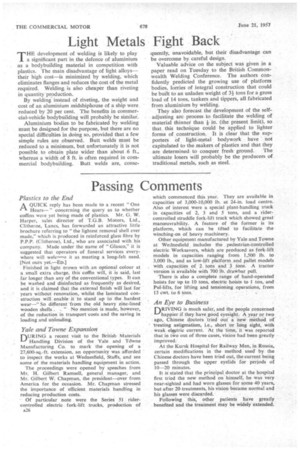Passing Comments
Page 28

Page 29

If you've noticed an error in this article please click here to report it so we can fix it.
Plastics to the End
AQUICK reply has been made to a recent "One Hears—" concerning the query as to whether coffins were yet being made of plastics. Mr. G. W. Harper, sales director of T.G.B. Motors, Ltd., Clitheroe, Lanes, has forwarded an attractive little brochure referring to "the lightest removal shell ever made," which is produced in reinforced glass fibre by P.P.P. (Clitheroe), Ltd., who are associated with his company. Made under the name of "Glasco," it is suggested that operators of funeral services everywhere will welcome it as meeting a long-felt need. [Not ours yet.—ED.] Finished in light orown with anoptional colour at a small extra charge, this coffin will, it is said, last far longer than any of the conventional types. It can be washed and disinfected as frequently as desired, and it is claimed that the external finish will last for • years without renovation, whilst the laminated construction willenable it to stand up to the hardest wear—" So different from the old heavy zinc-lined'
wooden shells., " No mention is made, however, of the reduction in transport costs and the saving in loading and unloading.
Yak and Towne Expansion
DURING a recent visit to the British Materials Handling Division of the Yale and TrIwne Manufacturing Co. to mark the opening of a 27,600-sq.-ft. extension, an opportunity was afforded to inspect the works at Wednesfield, Staffs, and see some of the materials handling equipment in action.
The proceedings were opened by speeches from Mr. H. Gilbert Ramsell, general manager, and Mr. Gilbert W. Chapman, the president—over from America for the occasion. Mr. Chapman stressed the importance of efficient materials handling in reducing production costs.
Of particular note were the Series 51 . ridercontrolled electric fork-lift trucks, production of A26 which commenced this year. They are available in capacities of 3,000-10,000 lb. at 24-in, load centre. Also of interest were a special plant-handling truck in capacities of 2, 3 and 5 tons, and a ridercontrolled straddle fork-lift truck which showed great manceuvrability. A feature of the former is its platform, which can be tilted to facilitate the winching-on of heavy machinery.
Other equipment manufactured by Yale and Towne at Wednesfield . includes the pedestrian-controlled electric Worksavers, which are produced as fork-lift models in capacities ranging from 1,500 lb. to 3,000 lb., and as low-lift platform and pallet models with .capacities . of 2 tons and -3 tons. A tractor version is available with 700 lb. drawbar pull.
There is also a complete range of hand-operated hoists for up to 10 tons, electric hoists to I ton, and Pul-lifts, for lifting and tensioning operations, from 15 cvvt. to 6 tons. •
An Eye to Business
nRIVING is much safer, and the people concerned
1-4r happier. if they have good eyesight: A year or two ago, Chinese doctors tried• out a new method of ' treating astigmatism, i.e., short or long sight, with weak electric current. At the time, it was reported that in two out of three cases, vision had been greatly improved.
At the Kursk Hospital for Railway Men, in Russia, certain modifications in the method used by the Chinese doctors have been tried out, the current being passed through the upper eyelids for periods of 10-20 minutes.
It is' stated that the principal doctor at the hospital first tried the new method on himself, he was very near-sighted and had worn glasses for some 40 years, but after 20 treatments, his vision became normal and his glasses were discarded.
Following this, other patients have greatly benefited and the treatment may be widely extended.
"The Gateway of England"
A LTHOUGH today road transport does not figure r-t as prominently as rail in the shifting of traffic from Dover harbour, a book published by the Dover Harbour Board—" The Gateway of England," by Rivers Scott—recalls historic events concerning this port which may be regarded as road transport in its earliest forms.
In 1422, for example, there crossed to Dover the funeral entourage of Henry V, the Queen's train alone being said to have stretched "a league's distance." Five hundred lancers in black armour trooped by the hearse.
In the reign of Edward IV, an army was dispatched from Dover to France, the embarkation taking place over 20 days.
When Queen Elizabeth I made a " progress " through Kent in 1573, the head of her procession was cheered in the town as the tail laboured slowly up Folkestone Hill.
The book makes fascinating reading, and there is a good picture supplement. Each year nearly 2m.
passengers pass through Dover—almost half the total movement between Britain and the Continent, and more than a quarter of the traffic between this . country and the rest of the world. Dover, in fact, is claimed to be the largest passenger port in the world.
What "Traders" Had to Stand
F.fHE engineer in charge of Ford design, and respon
sible for the new Thames Trader range, was obviously not content merely to conduct road tests. He wanted to prove what they could do at real work. Two prototype tippers were, therefore, put on the job at a construction site.
During this test they covered 260,000 miles and carried 35,000 tons of material, and Mr. C. L. Williams,. the engineer in question, expressed himself as most satisfied at the results.
Additionally, to try out the new rear axle, which has a pressed-steel housing, another prototype, after completing a mileage practically equal to the normal lifetime of such a vehicle, was driven for 300 miles on the Pave at the Ford testing ground, and 'withstood this arduous trial with flying colours.




























































































